Zalman CNPS14X CPU Cooler Review

Having skipped the 13th cooler series for understandable reasons, Zalman continues their product like with the 14th series of products and namely with the new CNPS14X model.
The South Korean Zalman Tech Co., Ltd. is an old-timer and one of the leaders in the market for computer component cooling. Times have passed when Zalman brand delivered absolutely the best processor coolers and was in fact the trend-setter in this field. Today we could name at least another 4-6 makers, which products could deliver at least the same cooling efficiency at the same or even lower price. Nevertheless, Zalman is not ready to give in. They are currently offering a flagship CNPS12X cooler priced at over $90, an entry-level CNPS10X Optima priced at $35, a Zalman CNPS20LQ liquid-cooling system and a variety of other coolers. They have recently expanded their family with a new Zalman CNPS14X model, which will be the main hero of our today’s review.
Packaging and Accessories
The front side of the packaging is decorated with the photograph of the cooler in a cloud of pearl fog:
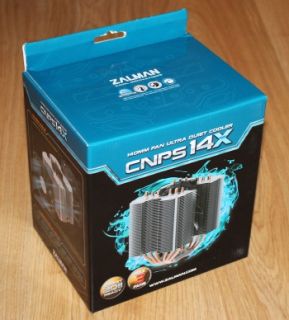
It looks pretty, but no more than that. I doubt that there is some kind of hidden meaning in this image, because no overclocker will ever want the cooler to start smoking, even if the smoke is of pretty pearl kind like that 🙂
The other sides of the packaging are, as usual, pretty informative:
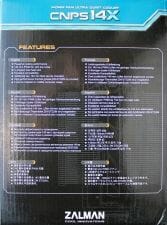
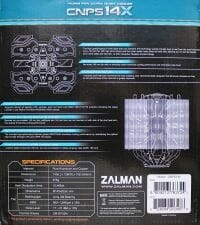
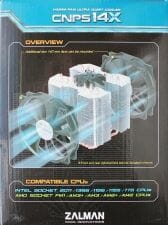
The cooler inside the box is secured in soft polyurethane foam insert. On top of it you will find all the included accessories, such as a universal backplate and retention brackets, plastic caps, screws, a special wrench, wire clips for additional fans, ZM-STG2M thermal paste, installation guide and a Zalman logo sticker:
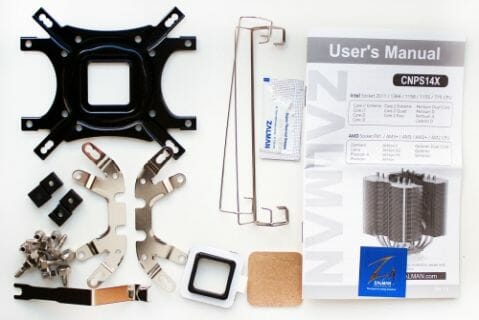
The cooler is manufactured in Korea and comes with 1-year warranty. Its recommended retail price is set at $54.99, which is not expensive at all for a Zalman product.
Design and Functionality
Zalman engineers decided to try the dual-array design with the fan inserted between the heatsink arrays in their new CNPS14X cooler. Zalman already had products featuring two-array heatsinks, but all of them were radial ones. Here we see two rectangular heatsink arrays, which are pierced vertically with the heatpipes:
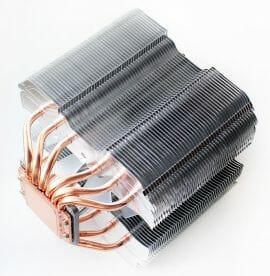
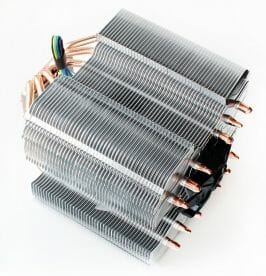
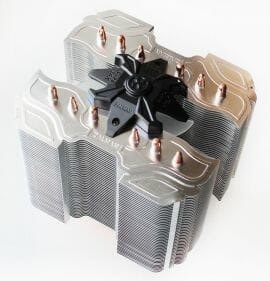
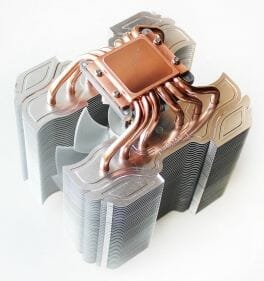
At the same time, unlike the majority of other coolers with dual-array heatsink design, Zalman CNPS14X doesn’t look bulky. On the contrary it makes an impression of a very light-weight and fine product. Despite this fact, its dimensions are very similar to what other super-coolers have to offer: 140x126x159.3 mm:
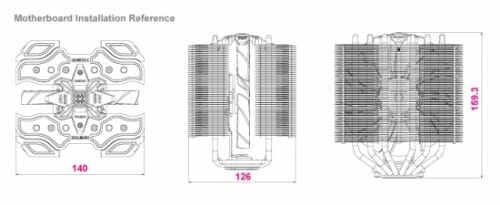
The cooler weighs 875 grams.
Each heatsink arrays consists of 45 aluminum fins, each 0.4 mm thick. They are pressed firmly against the heatpipes 1.0 mm away from one another:
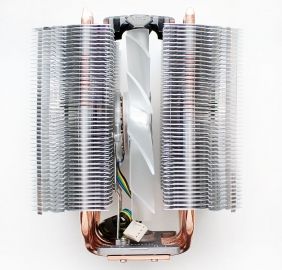
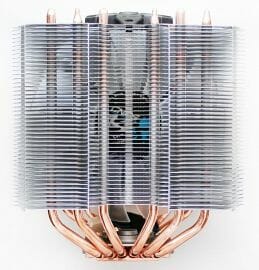
There are six heatpipes, each 6 mm in diameter. They go through the copper base plate and pierce the heatsink arrays in a perfect straight line:
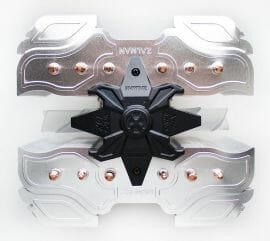
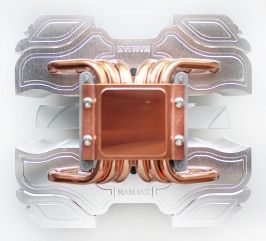
Unlike Zalman CNPS12X, the new cooler doesn’t use Zalman’s proprietary composite heatpipes with 50% higher efficiency. This is probably why its price is so affordable. Although it is a real pity that these awesome heatpipes aren’t utilized here.
Here I have to add that the cooler’s effective heatsink surface is 10,466 cm2.
Each heatsink fin has embossed design pressed into them as well as an embossed Zalman logo:
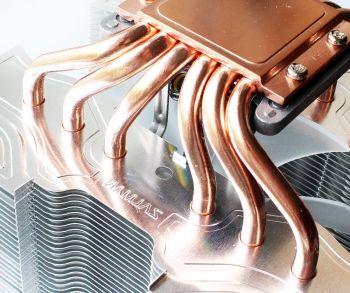
The base plate has special grooves for the heatpipes, which are soldered to the copper plate for added contact efficiency:
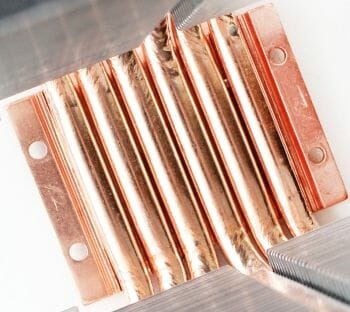
The base surface is decently finished, but the reflection of our test figurine is pretty far from mirror perfection:
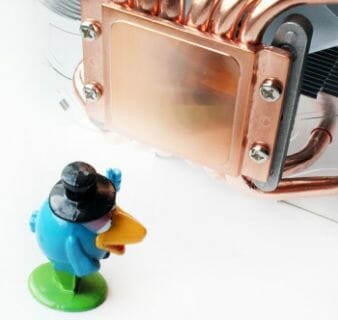
Zalman rarely has issues with the base evenness and the new Zalman CNPS14X is no exception. The base surface is exceptionally even all the way, and the thermal paste imprints left by our test processor are practically ideal:
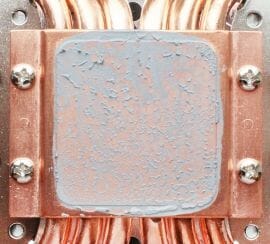
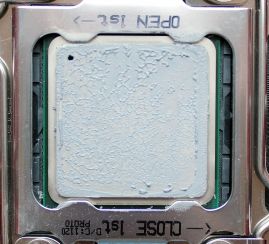
There is a 135 mm fan installed between the two heatsink arrays on a two-leg steel stand:
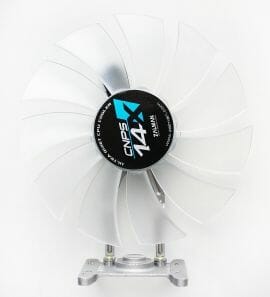
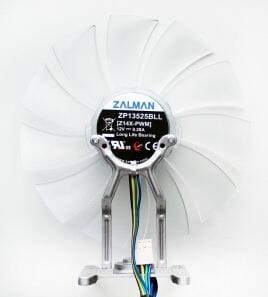
It looks very similar to the ZM-F4 fan, but is marked as ZP13525BLL. The rotation speed is automatically adjusted using PWM method in the interval from 950 to 1350 RPM generating between 17 and 21 dBA of noise. The fan specifications do not mention the static pressure or airflow. The enhanced slide bearing in the fan should last at least 50,000 hours or 5.7 years of non-stop operation. The maximum fan power consumption shouldn’t exceed 3.4 W. Our measurements showed that this fan didn’t need more than 1.9 W of power and could easily start at 3.5 V voltage.
With the included wire clips you can attach two additional fans to the new Zalman CNPS14X cooler:
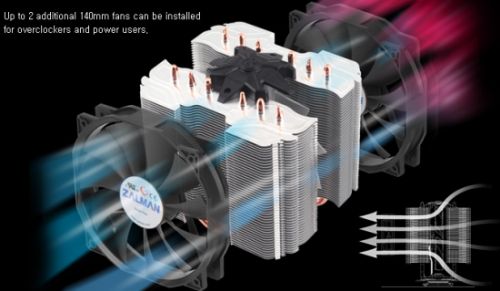
Zalman specifically recommends this particular configuration for overclocker systems.
Compatibility and Installation
Zalman CNPS14X is compatible with all contemporary platforms and the installation procedure is very easy and intuitive and shouldn’t pose any problems even for inexperienced users. The first step for any platform is to attach the universal retention brackets to the base of the cooler:
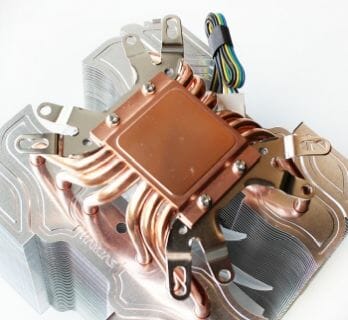
They are so universal that we could only install the cooler onto our LGA 2011 mainboard in one position, because when we turned it by 90 degrees, the AMD retention loops would interfere with the heatsinks on the processor voltage regulator components and wouldn’t let us position the cooler exactly in the middle of the CPU heat-spreader.
Now comes the most interesting part: using a special wrench you should evenly tighten the retention screws holding the brackets:
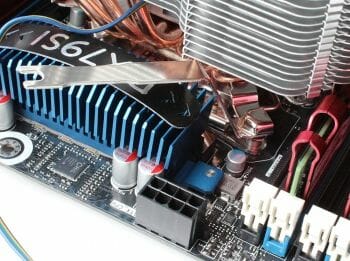
And trust me, this is a real challenge! Since the heatsinks on the VRM components and the tall memory module heat-spreaders are very close to the cooler, this wrench can only go 1/3 of the turn at a time at best. Moreover, it constantly slips, which makes this seemingly simple task take even longer. There is absolutely no way you could use any alternative tools, because the screws are directly beneath the heatsink. Anyway, after about 15-20 minutes of suffering, the cooler was secured in place. No kidding: this is the procedure you really want to do only once.
As for the clearance between the mainboard PCB and the lowest heatsink fin, here everything is fine and there is no interference with any of the heatsinks on the mainboard or memory modules:

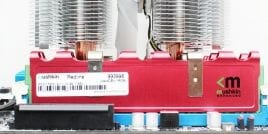

The new Zalman cooler looks very attractive inside a system case:
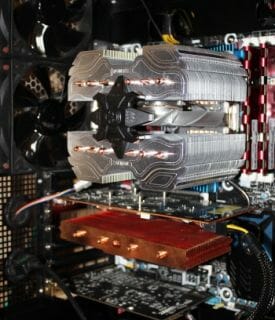
The cherry on top could be some fan LEDs with mild glow, IMHO.
Technical Specifications and Recommended Pricing
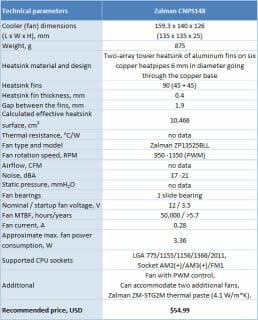
Testbed Configuration and Testing Methodology
We tested all coolers inside a closed system case with the following configuration:
- Mainboard: Intel Siler DX79SI (Intel X79 Express, LGA 2011, BIOS 0537 from 07/23/2012);
- CPU: Intel Core i7-3960X Extreme Edition, 3.3 GHz, 1.2 V, 6 x 256 KB L2, 15 MB L3 (Sandy Bridge-E, C1, 32 nm);
- Thermal interface: ARCTIC MX-4;
- Graphics card: Asus Radeon HD 6770 DirectCU Silent (EAH6770 DCSL/2DI/1GD5) GDDR5 128 bit, 850/4000 MHz (with a passive heatsink from the DeepCool V4000 VGA cooler);
- System memory: DDR3 4 x 4GB Mushkin Redline (Spec: 2133 MHz / 9-11-10-28 / 1.65 V);
- System drive: Crucial m4 256 GB SSD (SATA-III,CT256M4SSD2, BIOS v0009);
- Drive for programs and games: Western Digital VelociRaptor (300GB, SATA-II, 10000 RPM, 16MB cache, NCQ) inside Scythe Quiet Drive 3.5” HDD silencer and cooler;
- Backup drive: Samsung Ecogreen F4 HD204UI (SATA-II, 2 TB, 5400 RPM, 32 MB, NCQ);
- System case: Antec Twelve Hundred (front panel: three Noiseblocker NB-Multiframe S-Series MF12-S2 fans at 1020 RPM; back panel: two Noiseblocker NB-BlackSilent PRO PL-1 fans at 1020 RPM; top panel: standard 200 mm fan at 400 RPM);
- Control and monitoring panel: Zalman ZM-MFC3;
- Power supply: Seasonic SS-1000XP Active PFC F3 1000 W (with a default 120 mm fan).
For the primary tests and summary diagrams we overclocked our six-core processor with the clock generator frequency set at 125 MHz, the multiplier at 35x and “Load-Line Calibration” enabled to 4.375 GHz. The nominal processor Vcore was increased to 1.385 V in the mainboard BIOS. After that we tested the new coolers at even higher frequency and voltage settings. Turbo Boost was disabled during this test session, and Hyper-Threading technology was enabled to increase the heat dissipation. The memory voltage was at 1.65 V and its frequency was 2000 MHz with 9-10-10-28 timings. All other parameters available in the mainboard BIOS and related to CPU or memory overclocking remained unchanged.
All tests were performed under Windows 7 Ultimate x64 SP1 operating system. We used the following software during our test session:
- LinX AVX Edition version 0.6.4 – to load the processor (memory – 4500 MB, Problem Size – 24234, two 11-minute cycles);
- Real Temp GT version 3.70 – to monitor the processor core temperatures;
- Intel Extreme Tuning Utility version 3.1.201.5 – for monitoring and visual control of all system parameters during overclocking.
So, the complete screenshot during the test session looks as follows:
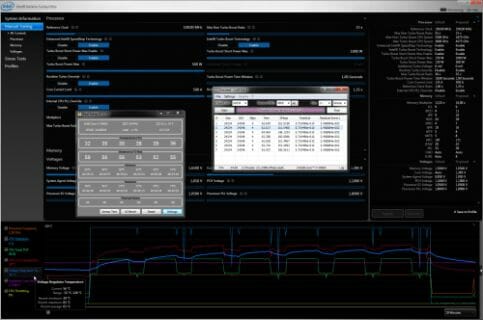
The CPU was loaded with two consecutive LinX AVX test runs with the settings as indicated above. The stabilization period for the CPU temperature between the two test cycles was about 8-10 minutes. We took the maximum temperature of the hottest CPU core for the results charts. Moreover, we will also provide a table with the temperature readings for all cores including their average values. The ambient temperature was checked next to the system case with an electronic thermometer with 0.1 °C precision that allows hourly monitoring of the temperature changes over the past 6 hours. The room temperature during our test session varied between 21.8-22.2°C.
The noise level of each cooler was measured between 1:00 and 3:00 AM in a closed room about 20 m2 big using CENTER-321 electronic noise meter. The noise level for each cooler was tested outside the system case when the only noise sources in the lab were the cooler and its fan. The noise meter was installed on a tripod and was always at a 150 mm distance from the cooler fan rotor. The tested cooling systems were placed at the edge of the desk on a sheet of polyurethane foam. The lowest noise reading our noise meter device can register is 29.8 dBA and the subjectively comfortable noise level in these testing conditions was around 36 dBA (do not mix it up with low noise level). The fan(s) rotation speed was adjusted in the entire supported range using our in-house controller by changing the voltage with 0.5 V increment.
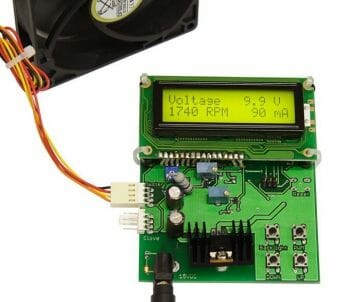
We are going to compare the new Zalman CNPS14X against our ultimate reference – Phanteks PH-TC14PE cooler with two default PH-F140TS fans:
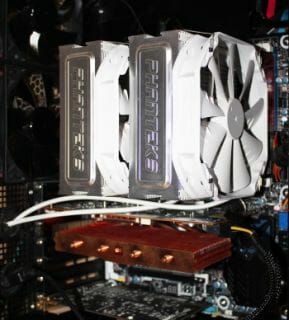
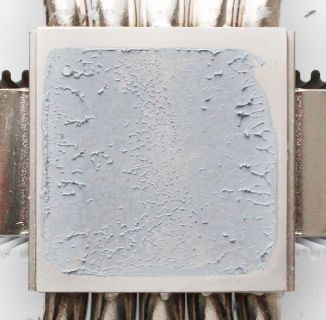
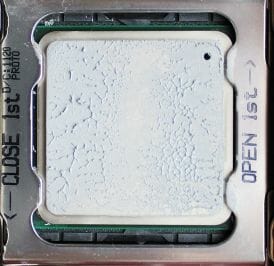
Moreover, we also had at our disposal a new modification of the Coolink Corator DS cooler for LGA 2011 platform:
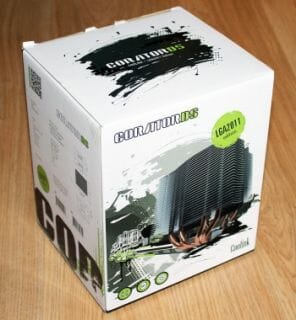
This is another two-array tower cooler with a similar price as the new Zalman CNPS14X. It boasts improved heatpipe direct contact technology:
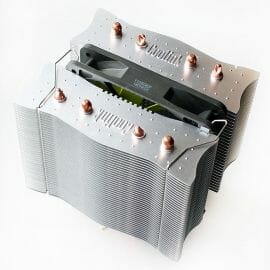
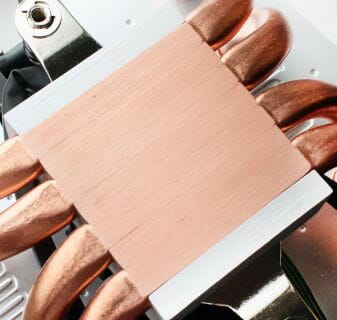
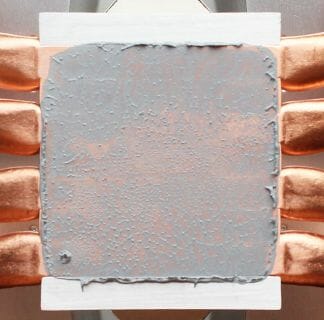
By default, this cooler comes with a single 120 mm fan, Coolink SWiF2-120P, which supports PWM rotation speed control. This is the fan we will use during our today’s test session:
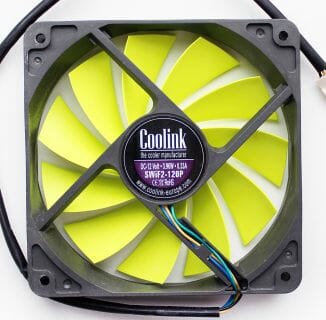
We also tested the Coolink Corator DS with two 135 mm Zalman ZM-F4 fans:
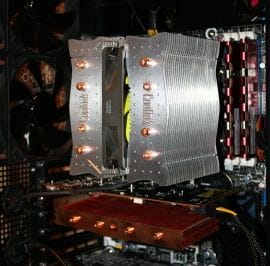
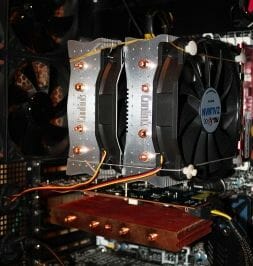
The new Zalman CNPS14X cooler was also tested with the same fans:
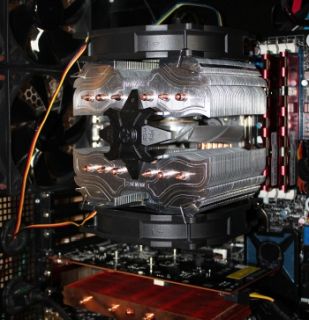
I would also like to add that the rotation speed of all fans was controlled using the same special controller I mentioned above with ±10 RPM precision.
Performance
Cooling Efficiency
The results of our cooling efficiency tests are given on the following diagram and in the following table:
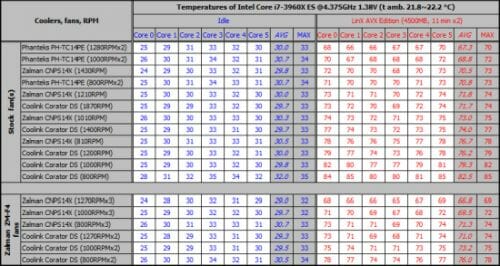
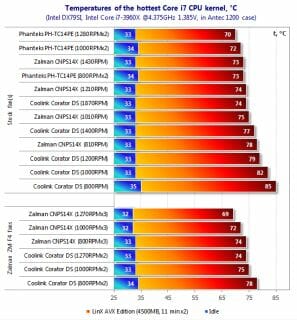
New Zalman cooler performs very well here. For example, when tested with its default fan rotating at its maximum speed, CNPS14X is just a tiny bit behind Phanteks PH-TC14PE, which is currently the best super-cooler out there. What an excellent result! As the fan slows down by 200 RPM, the CPU temperature increases only by 1°C, and the same happens when the fan speed is lowered by another 200 RPM. only at the minimal 810 RPM fan speed, Zalman CNPS14X cools our test processor 3°C worse than at 1000 RPM and the peak temperature of the overclocked six-core CPU doesn’t exceed 78°C. Compared against Cooling Corator DS, the new Zalman CNPS14X cooler has obviously won.
The results demonstrated by these coolers with alternative Zalman ZM-F4 fans are also very interesting to check out. A pair of additional 135 mm fans boosts the cooling efficiency of the new Zalman cooler by as much as 4°C, which allows it to outperform Phanteks PH-TC14PE. Having extra fans is also quite beneficial at lower fan speeds: at 1000 RPM the cooler does 3°C better than in its default configuration, and at 800 RPM – 4°C better. Despite the fact that additional fans also helped Coolink Corator DS, it cannot compete against Zalman CNPS14X and consistently falls 3-5°C behind under maximum load.
You can compare the results of our today’s testing participants against the previously tested products in the following table and diagram*. Each cooler was tested in its default configuration in the quiet mode and at the maximum speed of the fan(s) with the CPU overclocked to 4.375 MHz at 1.385 V Vcore.
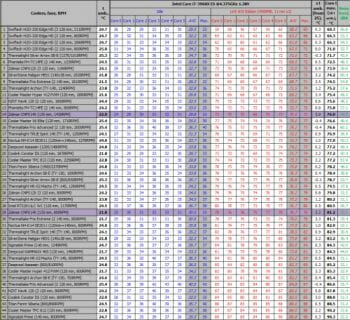
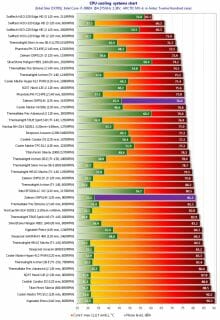
The new cooler from Zalman looks very good in this diagram, too. At the maximum rotation speed of its default fan it managed to outperform such well-known products as Thermalright TRUE Spirit 140 and Noctua NH-D14 SE2011, and at the minimal 800 RPM is successfully competed against a variety of products from different makers.
As for the maximum CPU overclocking results, Zalman CNPS14X managed to keep the CPU stable at 4500 MHz with 1.425 V Vcore and 75°C peak temperature of the hottest core:
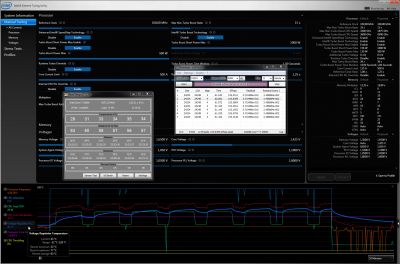
In our overall rating chart for maximum processor overclocking it takes one of the top spots yielding only to four super-coolers including Zalman CNPS12X:
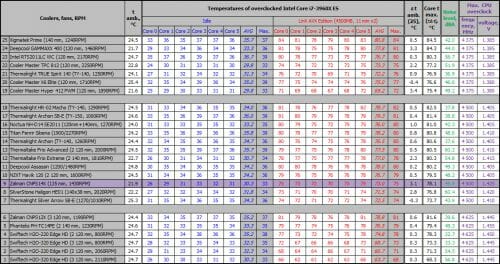
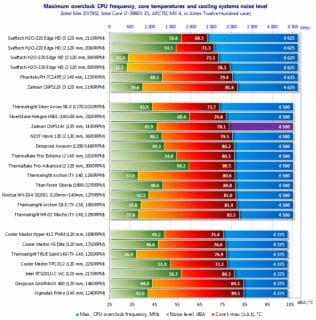
Acoustic Performance
We measured the noise level of our coolers throughout the entire speed range of their fans, as described in the chapter on testing methodology. Here are the results:
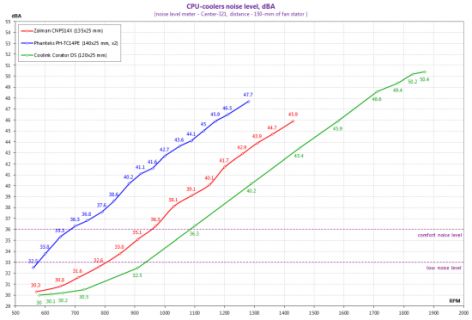
In our subjective opinion, the noise level of the new Zalman CNPS14X cooler falls somewhere in the middle between Phanteks and Cooling. And the tests confirmed this assumption clearly: Zalman’s noise curve runs precisely between those for Phanteks and Cooling. We already know that Phanteks fans are not particularly quiet, therefore, it was fairly easy for Zalman to outdo them in terms of acoustic comfort, although it failed to take the lead away from the high-quality Coolink fan. Zalman CNPS14X fan can be considered acoustically comfortable at up to 960 RPM and quiet at up to 800 RPM. It doesn’t crackle or vibrate at low speeds, and doesn’t produce any electrical noises. Overall, it is a very good an inexpensive fan (judging by the price of its retail modification).
Conclusion
Zalman CNPS14X is a remarkable cooler with superb cooling efficiency that comes at a relatively low price. If we look at the prices of the four super-coolers that rank above Zalman CNPS14X in our rating chart, you will see that all of them are priced way above $54.99. Therefore, we have every right to call Zalman CNPS14X a great choice for overclocking fans as well as for regular users need efficient cooling like that. Universal design, reliable retention, ability to accommodate another two fans, attractive exterior and beautiful packaging – all these are indisputable strengths of the new Zalman CNPS14X. The only bad egg in this basket is the ridiculously inconvenient installation procedure. Therefore, if you are looking for a cooler that you will only install once until time comes for the CPU upgrade with the new generation processor, then you can put up with 20 minutes of suffering and then forget all about it once and for all. Other than that, Zalman CNPS14X is an excellent product, which we can definitely recommend, and we have no other concerns about it of any kind.